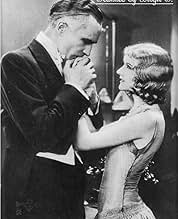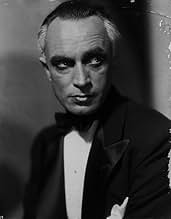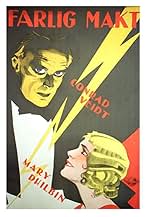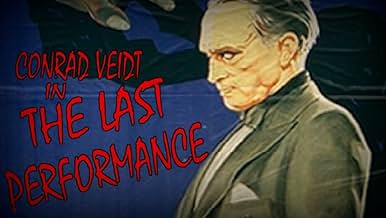Ajouter une intrigue dans votre langueA middle-aged magician is in love with his beautiful young assistant, who is in love with his young protege', who turns out to be a bum and a thief.A middle-aged magician is in love with his beautiful young assistant, who is in love with his young protege', who turns out to be a bum and a thief.A middle-aged magician is in love with his beautiful young assistant, who is in love with his young protege', who turns out to be a bum and a thief.
- Réalisation
- Scénario
- Casting principal
Fred MacKaye
- Mark Royce
- (as Fred Mac Kaye)
Gusztáv Pártos
- Theatre Manager
- (as Gustav Paros)
Walter Brennan
- Clown
- (non crédité)
Rosita Delmar
- Undetermined Secondary Role
- (non crédité)
Greta Granstedt
- Sister Act
- (non crédité)
Julia Griffith
- Sword Trick Spectator
- (non crédité)
Ruth Jennings
- Sister Act
- (non crédité)
Bela Lugosi
- Erik's Screen Voice in Hungarian Version
- (voix)
- (non crédité)
Rolfe Sedan
- Clothing Store Clerk
- (non crédité)
Avis à la une
Often termed a horror film (due to it's background of stage magic) this is really a tale of thwarted love. Conrad Veidt excels as the kindly Erik the Great who finds his soon to be bride has fallen in love with one of his assistants. The discovery scene is a superb piece of acting from Veidt, as he shifts from shock to heartbreak, struggling to be magnanimous, and then gradually to cold calculation with the subtlest changes of expression.
These moments and a dynamic trial scene elevate what is otherwise an okay backstage melodrama into a truly compelling tale of jealousy and redemption. Palo Fejos, director of the wonderful "Lonesome", injects some stylish visuals.
The version I've seen is a truncated and mute print of 48 minutes, so I may have missed some of the film's finer points.
These moments and a dynamic trial scene elevate what is otherwise an okay backstage melodrama into a truly compelling tale of jealousy and redemption. Palo Fejos, director of the wonderful "Lonesome", injects some stylish visuals.
The version I've seen is a truncated and mute print of 48 minutes, so I may have missed some of the film's finer points.
Famed magician, hypnotist Erik the Great (Conrad Veidt) has a Svengali issue with his comely underage assistant Julie (Mary Philbin). Awaiting the day for her to turn 18 he stage manages an over the top dinner party to announce their engagement. Unfortunately due to his charitable ways he takes on a second story man as an assistant who Julie falls for much to the delight of Erik's other bitter assistant.
A last gasp (1929) silent featuring some outstanding set design, tracking shots and the magnetic mugs of Veidt and Philbin, The Last Performance allows itself little time to build (barely an hour) with the young lovers clicking in no time with little development. The incredibly graceful and intimidating Veidt with his hands and eyes is always a fascinating watch especially when he has to do a painful 180 at the engagement soiree. The bottom falls out in the second half though with a revenge plot playing out tediously and a Perry Mason like finale for the ages. The Last Performance is a poor one.
A last gasp (1929) silent featuring some outstanding set design, tracking shots and the magnetic mugs of Veidt and Philbin, The Last Performance allows itself little time to build (barely an hour) with the young lovers clicking in no time with little development. The incredibly graceful and intimidating Veidt with his hands and eyes is always a fascinating watch especially when he has to do a painful 180 at the engagement soiree. The bottom falls out in the second half though with a revenge plot playing out tediously and a Perry Mason like finale for the ages. The Last Performance is a poor one.
Conrad Veidt is a stage magician with two assistants. One is Leslie Fenton. The other is Mary Philbin, with whom Veidt is in love. One evening, Fred MacKaye breaks into Veidt's hotel room and is caught.... hungrily eating Veidt's dinner. Veidt takes him on as a third assistant. Then he catches MacKaye and Miss Philbin canoodling; he olympically wishes them well, but one evening, doing the trick where Fenton is placed in a trunk and MacKaye shoves swords into the trunk, something goes wrong, and Fenton is discovered in the trunk, stabbed to death. MacKaye is arrested.
Veidt offers one of his great performances; the blacking he wears around his eyes to make him look devilish makes me wonder how he would have been playing Dracula in Tod Browning's version of the movie. In many ways, this looks likes a variation on the sort of formulaic movie that Lon Chaney was starring in at MGM at the moment... although Veidt's performance never asks for our sympathy. He simply dominates everyone.
Veidt offers one of his great performances; the blacking he wears around his eyes to make him look devilish makes me wonder how he would have been playing Dracula in Tod Browning's version of the movie. In many ways, this looks likes a variation on the sort of formulaic movie that Lon Chaney was starring in at MGM at the moment... although Veidt's performance never asks for our sympathy. He simply dominates everyone.
Universal was enamored of setting stories in the theater, weren't they? Perhaps "Phantom of the Opera" set the precedence. "The Last Warning" featured a masked murderer terrorizing Broadway. "The Last Performance" sets a love triangle among a magic act. Once again, Mary Philbin plays the object of desire of a murderous older man. While "Phantom" had obvious grotesque attributes and "The Last Warning" was basically an old dark house mystery, "The Last Performance" is a melodrama with light fantastic elements.
The story is typical. Erik the Great, a stage magician and hypnotist, is in love with Julie, his female assistant. He plans to marry the girl as soon as she turns eighteen, a story turn likely to gross out modern audiences. Julie only has eyes for Mark, a vagabond that Erik takes under his wing. "The Last Performance" neatly follows the three-act structure, with Erik discovering the truth about his love at the 18 minute point, the "seven swords through the box" magic trick going predictably wrong half-way through, and the last act set during a trial, with the case-solving testimony serving as a concise climax.
Of most interest to horror fans is Conrad Veidt's performance. Veidt was made for the silents. He says so much with simply a shift of his brow, expressing heart-break or jealousy with only his face. Despite the temptation to compare the two, Erik the Great isn't Erik the Phantom. He's not a monster, rather a fair man who commits wrong only out of love. The hypnotism sequences make great use of his glaring eyes. No wonder Veidt was nearly Dracula. Conrad's performance alone makes the sappy finale believable. The rest of the cast is thin, with Mary Philbin making goo-goo eyes at Fred MacKaye, a marginal matinée hero.
While lighter on expressionistic atmosphere then you'd hope, "The Last Performance" still has several stand-out moments. An early bit has Veidt walking a catwalk, shadows criss-crossing over his face. When the lover's affair is revealed, his shadow is cast huge on the wall, dwarfing the girl and her mate. Veidt's power as a hypnotist is displayed by overlaying his glaring face over the character performing the requested action. A memorable early scene has the man mesmerizing a skeptical audience member, their theater booth suddenly spinning around them.
"The Last Performance" is another example of routine silent film material elevated by its lead actor. After years of obscurity, the film was recently released by the Criterion Collection Kind of. It's a special feature packaged with "Lonesome," a later film by the same director. This version has Danish titles with English subtitles and is apparently missing several sound sequences. The film is concise enough that I can't imagine those scenes would add much.
The story is typical. Erik the Great, a stage magician and hypnotist, is in love with Julie, his female assistant. He plans to marry the girl as soon as she turns eighteen, a story turn likely to gross out modern audiences. Julie only has eyes for Mark, a vagabond that Erik takes under his wing. "The Last Performance" neatly follows the three-act structure, with Erik discovering the truth about his love at the 18 minute point, the "seven swords through the box" magic trick going predictably wrong half-way through, and the last act set during a trial, with the case-solving testimony serving as a concise climax.
Of most interest to horror fans is Conrad Veidt's performance. Veidt was made for the silents. He says so much with simply a shift of his brow, expressing heart-break or jealousy with only his face. Despite the temptation to compare the two, Erik the Great isn't Erik the Phantom. He's not a monster, rather a fair man who commits wrong only out of love. The hypnotism sequences make great use of his glaring eyes. No wonder Veidt was nearly Dracula. Conrad's performance alone makes the sappy finale believable. The rest of the cast is thin, with Mary Philbin making goo-goo eyes at Fred MacKaye, a marginal matinée hero.
While lighter on expressionistic atmosphere then you'd hope, "The Last Performance" still has several stand-out moments. An early bit has Veidt walking a catwalk, shadows criss-crossing over his face. When the lover's affair is revealed, his shadow is cast huge on the wall, dwarfing the girl and her mate. Veidt's power as a hypnotist is displayed by overlaying his glaring face over the character performing the requested action. A memorable early scene has the man mesmerizing a skeptical audience member, their theater booth suddenly spinning around them.
"The Last Performance" is another example of routine silent film material elevated by its lead actor. After years of obscurity, the film was recently released by the Criterion Collection Kind of. It's a special feature packaged with "Lonesome," a later film by the same director. This version has Danish titles with English subtitles and is apparently missing several sound sequences. The film is concise enough that I can't imagine those scenes would add much.
THE STORY & GENRE -- Stage magician Conrad Veidt in standard love-triangle revenge tale. This gets quite grisly in the courtroom scene! And he really has hypnotic powers (briefly early), so this counts 100%.
THE VERDICT -- The evocative Veidt elevates this from mere pathos, which culminates in revenge, to the highest level of silent art (the sound version is apparently lost). The close camera-work is in his favor as every nuance of his expression sting the viewer.
FREE ONLINE -- I believe all that's available is a silent Danish print with English subtitles.
THE VERDICT -- The evocative Veidt elevates this from mere pathos, which culminates in revenge, to the highest level of silent art (the sound version is apparently lost). The close camera-work is in his favor as every nuance of his expression sting the viewer.
FREE ONLINE -- I believe all that's available is a silent Danish print with English subtitles.
Le saviez-vous
- AnecdotesBela Lugosi dubbed Conrad Veidt's voice for the Hungarian version.
- Citations
Erik the Great: I killed Buffo Black--and placed the guilt on Mark Royce, I thought if Mark were out of the way, Julie would come back to me, but they love each other and I am old... there's nothing left in life for me--it was murder, Your Honor and I will pay!
Meilleurs choix
Connectez-vous pour évaluer et suivre la liste de favoris afin de recevoir des recommandations personnalisées
Détails
- Date de sortie
- Pays d’origine
- Langue
- Aussi connu sous le nom de
- The Last Performance
- Lieux de tournage
- Société de production
- Voir plus de crédits d'entreprise sur IMDbPro
- Durée1 heure 8 minutes
- Mixage
Contribuer à cette page
Suggérer une modification ou ajouter du contenu manquant

Lacune principale
By what name was Erik le mystérieux (1929) officially released in Canada in English?
Répondre































